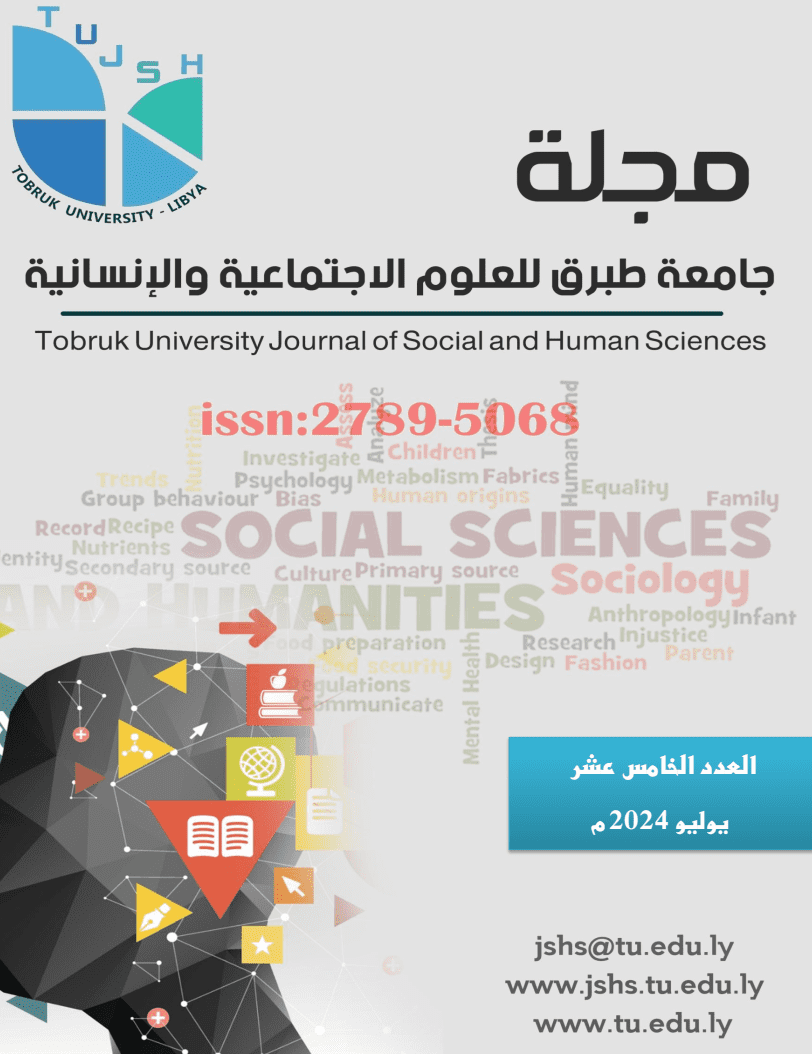The Grammatical Function and its Relation to Meaning
DOI:
https://doi.org/10.64516/776kg865Keywords:
الوظيفة النحوية, الارتباط بالمعنى, تراكيب الجملة الفعلية, نظرية النظمAbstract
Grammar is currently a branch of linguistics, and it focuses on the function that words perform in the composition of verbal sentences and nominal sentences, as well as the associated topics and vocabulary in grammar books. The theory of Abdul-Qahir al-Jurjani is the "theory of system" which he built on the rules of grammar, and in which he states that the meanings of grammar and its rulings are what connect the words, compose them, and make some of them a cause of others in terms of agency or effectiveness or any other grammatical functions.some have noted that Arabic grammar is a grammar of functions, and that the inflectional marks are indicators and evidence of these functions, despite the fact that many grammatical functions share the same inflectional mark, especially the accusative cases. The grammatical function refers to the grammatical position that the word occupies due to its relationship with the other linguistic elements in the structure. It may be original or complementary, such as the adjective, the circumstantial accusative, the agency, the annexation, and others. Or it is what the connecting and associated words convey in terms of grammatical meanings, as they are the verb, the subject, the object, the circumstantial accusative, the specification, or the adjective, and so on, as detailed by grammarians in the well-known chapters of grammar. The old grammarians classified these words, whether connectors or associated, into three categories called (parts of speech): the noun, the verb, and the particle.The ranking (the original position) along with the inflectional mark of the word constitute a main basis on which the determination of the grammatical function is based.This research has defined the scope of its study of the grammatical function and the extent of its connection to meaning.
Downloads
References
1. ابن هشام، جمال الدين، تحقيق: محمد محي الدين عبد الحميد، الطبعة الثانية، دار الطلائع، القاهرة، 2004م.
2. أنيس، إبراهيم، من أسرار اللغة، الطبعة الثالثة 1966م، القاهرة، مكتبة الأنجلو المصرية.
3. جرادات، أسامة كامل جرادات، الأبعاد المعنوية في الوظائف النحوية، رسالة لاستكمال متطلبات الماجستيرـ الجامعة الهاشمية، نيسان 2003م.
4. توامة، عبد الجبار، المنهج الوظيفي العربي لتجديد النحو العربي، منشورات المجلس العلمي للغة العربية، الجزائر، 2001م.
5. حسان، تمام، الخلاصة النحوية، 2000م، القاهرة، عالم الكتب.
6. حسان، تمام، اللغة بين المعيارية والوصفية، 2001م، الطبعة الرابعة، القاهرة، عالم الكتب.
7. حسان، تمام، 2006م، اللغة العربية معناها ومبناها، الطبعة الخامسة، القاهرة، عالم الكتب.
8. حمراني، عبد القادر، المصطلح النحوي بين الشكل والدلالة، مجلة دراسات لسانية، المجلد الثالث، العدد الأول، 2019م.
9. سيبويه، عمرو بن عثمان بن قنبر، تحقيق: عبد السلام محمد هارون، مكتبة الخانجي، القاهرة، الطبعة الثالثة، 1480هـ، 1977م.
10. العقاد، عباس محمود، اللغة الشاعرة،1996م، الإنجلو المصرية.
11. فطوش، صفاء، وعشوري، مليكة، الوظائف النحوية وسياقها في ديوان "ابن المبارك" رسالة ماجستير، جامعة محمد خيضر، بسكرة، كلية الآداب واللغات، قسم الآداب واللغة العربية، 2019م.
12. الفهري، عبد القادر الفاسي اللسانيّات واللغة العربية، ط1، منشورات عويدات، بيروت، 1986.
13. المخزومي، مهدي، في النحو العربي، نقد وتوجيه، الطبعة الأولى، بيروت، 1964م.
14. مرات، خديجة، نظرية النحو الوظيفي، البنية والوظيفة، مجلة اللغة الوظيفية، المجلد 7، العدد 2، (31 ديسمبر/كانون الأول، 2020م) منشورات جامعة حسيبة بن بو علي شلف، مخبر نظرية اللغة الوظيفية. DOI: https://doi.org/10.54295/2201-007-002-008
15. المساري، بشير عبد الله علي، النحو بين المعيارية والدلالة، مجلة مهرة للعلوم الإنسانية، مجلة علمية دولية محكمة، العدد الثامن، يونيو 2020م. DOI: https://doi.org/10.71311/.v1i1.76
16. مصطفى، إبراهيم، إحياء النحو، القاهرة، مؤسسة هنداوي للتعليم والثقافة، 2012م.
17. الميساوي، خليفة، المصطلح اللساني وتأسيس المفهوم، دار الأمان، الرباط، الطبعة الأولى، 2013م.
18. النجار، لطيفة إبراهيم، الوظائف النحوّية بين المركزي والهامشي، "مثل من وظيفة الحال"، مجلة مجمع اللغة العربية الأردني، العدد 65، جامعة الإمارات العربيّة المتحدة.
19. ناصف، علي النجدي، من قضايا اللغة والنحو، مكتبة نهضة مصر.
Downloads
Published
Issue
Section
License
Copyright (c) 2024 الدكتورة ريما أحمد الكبير الناجح (Autor/in)

This work is licensed under a Creative Commons Attribution 4.0 International License.








